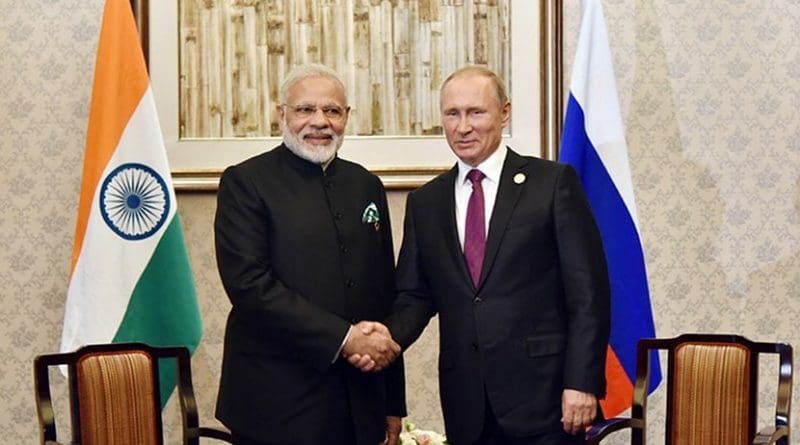Positive Signals In India-Russia Relations – Analysis
By Observer Research Foundation
By Aleksei Zakharov*
The outcome of the Xiamen Summit shows that BRICS remains an important forum for multilateral diplomacy as well as a valid instrument for calibrating bilateral ties. This year, beyond the forum’s overall agenda, one of the major spotlight was the meeting between Indian Prime Minister Narendra Modi and Chinese President Xi Jinping, as it was crucial for setting the pace for the onward Sino-Indian collaboration at the bilateral level and on the sidelines of multilateral formats. Sino-Indian relations are crucial not only in BRICS but also in the SCO. There was also a good meeting between the Indian Prime Minister and Russian President Vladimir Putin, though it was not counted among the focal points of the Xiamen Summit’s events. The meeting indicated a positive pattern for Indo-Russian relationship.
In the past few years, one of the apprehensions raised by the Indian strategic experts was the suspicion that Russia has become so closely interconnected with China that India can no more count on Moscow in case it needed the old friend’s shoulder to lean on. This had led to constraints on the bilateral partnership. The recent developments inside the Russia-India-China triangle, however, imply that Moscow follows a more balanced policy than one could expect, demonstrating a growing number of positive signals for New Delhi.
The first signal appeared on August 28 when the Russian Ambassador in China Andrey Denisov, several hours before India and China agreed to disengage from the Doklam dispute, stated: “We think our Chinese and Indian friends can resolve the problem by themselves. We don’t think they need any mediators who can influence their respective positions on the issue”. It is important that Russia’s neutral stand vis-a-vis the two partners was delivered on the Chinese soil. So, the Russian neutrality can be interpreted as the lack of support to China.
Second, the ‘Xiamen Declaration’ contained a reference to a number of Pakistan-based terrorist groups. And this was called ‘a diplomatic victory’ for India. It seems that Russia was not the last country who agreed to include this issue in the joint declaration. On the contrary, a year after the BRICS summit in Goa, Moscow and New Delhi have managed to move toward a closer understanding on the matter of terrorism. According to The Times of India, “Russia worked actively to convince China to drop its opposition to name-checking Pakistan-based Lashkar-e-Taiba (LeT) and Jaish-e-Muhammed (JeM)”.
The third positive sign was reflected in the discussions between Putin and Modi, which, besides issues in trade and investment, especially in oil and gas sector, cooperation in tourism, culture and student exchanges, also included most noteworthy subject of security situation in Afghanistan. This indicates an attempt to coordinate positions towards the resolution of the crisis in a country where both states have high stakes.
According to some media reports, the dialogue between Moscow and New Delhi on the Afghanistan crisis might be continued in October when President Putin’s special envoy for Afghanistan, Zamir Kabulov, visits India. The talks could mitigate India’s concerns over Moscow’s interaction with Taliban and help shape shared views of the ways to promote the Afghanistan peace process. It will be, however, highly important for the Russian side to accurately articulate its stand, since Mr. Kabulov’s remarks delivered to the press after the Heart of Asia (Istanbul Process) conference in December 2016 appeared to have hurt India.
Besides, the results of the Eastern Economic Forum (EEF) held in Vladivostok on September 6-7 show that Russia is trying to balance its foreign policy in Asia, engaging different regional powers to cooperate with it in the Far East. The Forum was attended by high-level delegations from Japan, South Korea, India and Vietnam whereas, by contrast, there was comparatively low presence of the Chinese officials and businessmen. The participation of the Indian delegation, headed by Minister of External Affairs Sushma Swaraj, in the EEF is a favourable sign of the bilateral attempts to push trade and economic ties between India and Russia.
In the recent years, Indian politicians and entrepreneurs have been regularly taking part in the economic events hosted by Russia. However, the two sides are still struggling to turn the high optics of the representatives’ meetings into mutually profitable collaboration. An initiative to create inter-country business dialogue – a new permanent advisory body which will bring together investors as well as governors of Russian Far East regions and the States of India – announced at the EEF, seems to be yet another step towards the state-guided cooperation. It remains to be seen how helpful this ‘advisory board’ will be. So far, its interaction has not been quite successful.
The two sides should utilise the propitious momentum of the growing political and diplomatic interactions to do away with the irritations of the past years. The summits between the leaders have proven to be the positive surges in the bilateral ties. The other layers of Russian and Indian officialdoms should keep this pace and show empathy to each other’s concerns to build on the favourable developments. After mitigating the geopolitical background of the relationship, New Delhi and Moscow could address the bilateral issues and embrace opportunities in the economic track of cooperation.
*The author is a Visiting Fellow at Observer Research Foundation, Delhi

